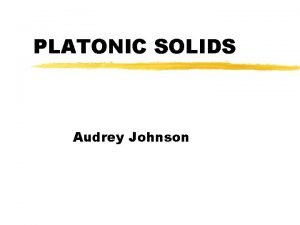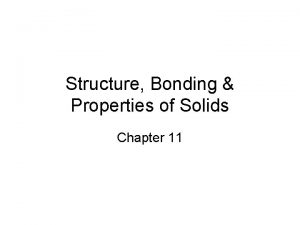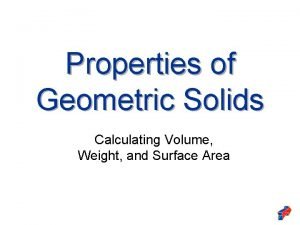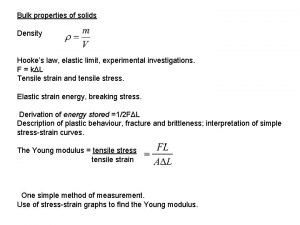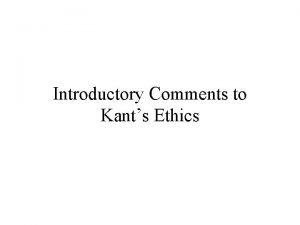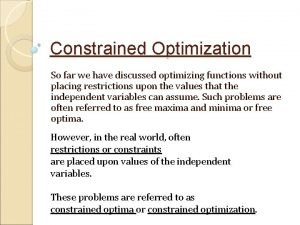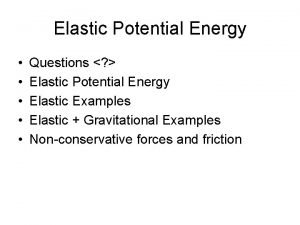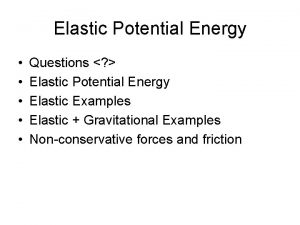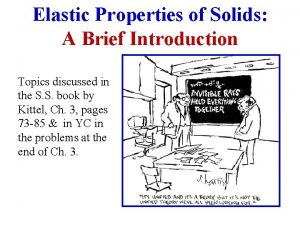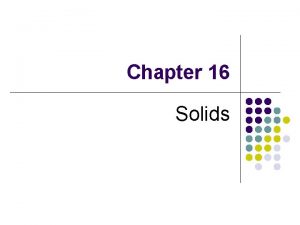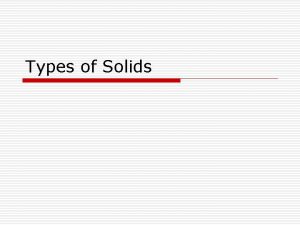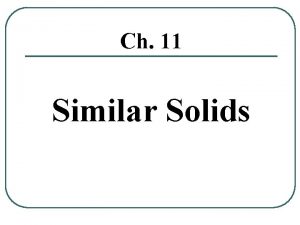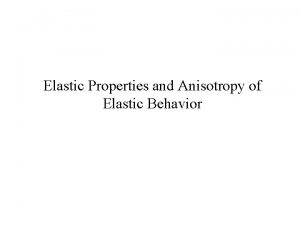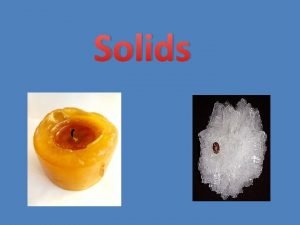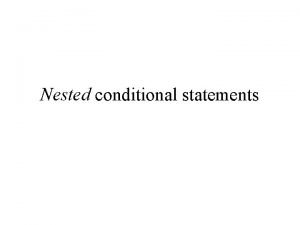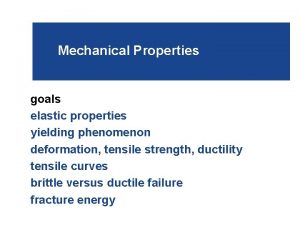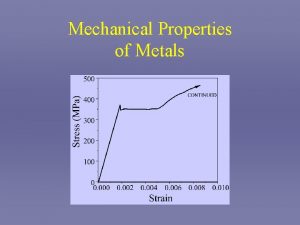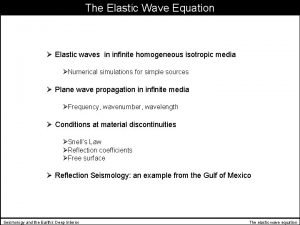Elastic Properties of Solids Part III Topics Discussed































- Slides: 31

Elastic Properties of Solids, Part III Topics Discussed in Kittel, Ch. 3, pages 73 -85 Another Lecture Found on the Internet!

Elastic and Complimentary Energy Density

= Uo + Co


Expressed in compliance matrix form = S·

Expressed in stiffness matrix form = C·

In general, stress-strain relationships such as these are known as constitutive relations Note that the stiffness matrix is traditionally represented by the symbol C, while S is reserved for the compliance matrix!

Internal Energy


Strains xy = 2 xy yz = 2 yz zx = 2 zx

Hooke’s Law (Anisotropic) The 36 coefficients C 11 to C 66 are called elastic coefficients

Hooke’s Law

Hooke’s Law The generalized Hooke’s law is an assumption, which is reasonably accurate for many material subjected to small strain, for a given temperature, time and location

Strain Energy Density

Isotropic materials have only 2 independent variables (i. e. elastic constants) in their stiffness and compliance matrices, as opposed to the 21 elastic constants in the general anisotropic case. anisotropic Eg: Metallic alloys and thermo-set polymers

The two elastic constants are usually expressed as the Young's modulus E and the Poisson's ratio n. Alternatively, elastic constants K (bulk modulus) and/or G (shear modulus) can also be used. For isotropic materials G and K can be found from E and n by a set of equations, and vice-versa.

Hooke's Law in Compliance Form

Hooke's Law in Stiffness Form

Youngs Modulus from Uniaxial Tension An isotropic material subjected to uniaxial tension in x direction, sxx is the only non-zero stress. The strains in the specimen are

The modulus of elasticity in tension, Young's modulus E, is the ratio of stress to strain on the loading plane along the loading direction. 2 nd Law of Thermodynamics and understanding that under uniaxial tension, material must elongate in length implies: E>0

Shear Modulus for Pure Shear Isotropic material subjected to pure shear, for instance, a cylindrical bar under torsion in the xy sense, sxy is the only non-zero stress. The strains in the specimen are

Shear modulus G: Ratio of shear stress to engineering shear strain on the loading plane

2 nd Law of Thermodynamics and understanding that a positive shear stress leads to a positive shear strain implies G>0

Since both G and E are required to be positive, the quantity in the denominator of G must also be positive. This requirement places a lower bound restriction on the range for Poisson's ratio, n > -1 G=E/2(1+ )

Bulk Modulus for Hydrostatic stress For an isotropic material subjected to hydrostatic pressure s, all shear stress will be zero and the normal stress will be uniform

Under hydrostatic load, material will change its volume. Its resistance to do so is termed as bulk modulus K, or modulus of compression. hydrostatic pressure K = relative volume change Also note: K > 0

The fact that both bulk modulus K and the elastic modulus E are required to be positive, it sets an upper bound of Poisson's ratio n < 1/2 K=E/ 3(1 -2 )

Orthotropic material has at least 2 orthogonal planes of symmetry, where material properties are independent of direction within each plane. Eg: Certain engineering materials, 2 -ply fiber-reinforced composites, piezoelectric materials (e. g. Rochelle salt) Orthotropic material require 9 independent variables (i. e. elastic constants) in their constitutive matrices.

The 9 elastic constants in orthotropic constitutive equations are comprised of 3 Young's modulii Ex, Ey, Ez, 3 Poisson's ratios nyz, nzx, nxy, 3 shear modulii Gyz, Gzx, Gxy. Note that, in orthotropic materials, there are no interaction between the normal stresses sx, sy, sz and the shear strains yz, zx, xy

Hooke’s law in compliance matrix form

Hooke’s law in stiffness matrix form End of session 2
 Elastic properties of solids
Elastic properties of solids Topics to be discussed
Topics to be discussed Perichondrium
Perichondrium Hamlet act iii scene iii
Hamlet act iii scene iii Solids liquids and gases section 2 properties of fluids
Solids liquids and gases section 2 properties of fluids Solid liquid gas information
Solid liquid gas information Properties of platonic solids
Properties of platonic solids Properties of a solid
Properties of a solid General properties of solids
General properties of solids Properties of network covalent solids
Properties of network covalent solids Superplasticity
Superplasticity How to calculate volume
How to calculate volume Properties of solid liquid and gas
Properties of solid liquid and gas Bulk density formula
Bulk density formula Current trends in media and information quiz
Current trends in media and information quiz As discussed
As discussed As discussed
As discussed The reform discussed by governor johnson in this excerpt -
The reform discussed by governor johnson in this excerpt - Which of these is not a force discussed in this chapter?
Which of these is not a force discussed in this chapter? I all of the questions correctly since
I all of the questions correctly since Lets have a recap
Lets have a recap So far we have discussed
So far we have discussed We discussed the problem
We discussed the problem Last time we discussed
Last time we discussed As we discussed before
As we discussed before Last time we discussed
Last time we discussed As discussed earlier meaning
As discussed earlier meaning Having discussed
Having discussed Va handbook 5017 part iii appendix a
Va handbook 5017 part iii appendix a Extensive vs intensive properties
Extensive vs intensive properties Chemical property of matter
Chemical property of matter More multiplication properties of exponents quiz part 1
More multiplication properties of exponents quiz part 1






